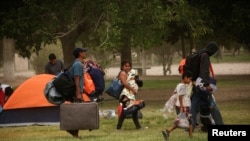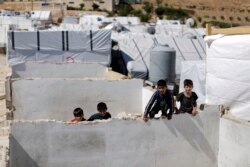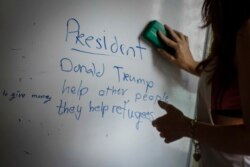The U.S. reached its self-imposed cap of 30,000 refugee arrivals Monday, the last day of the 2019 fiscal year, as the Trump administration eyes another major reduction in refugee admittances from across the globe for 2020.
More than half of refugees from Oct. 1, 2018 to Sept. 30, 2019 came from African nations, with Democratic Republic of Congo accounting for nearly 13,000 of those admitted.
Myanmar (4,932), Ukraine (4,451), Eritrea (1,757), and Afghanistan (1,198) rounded out the top five countries of origin. Iraq and Syria followed, each with fewer than 600.
Last year, the White House set the admissions ceiling at 45,000, of which less than half — 22,491 refugees — were resettled in the U.S.
Last week, the U.S. State Department announced it is seeking to resettle only 18,000 refugees in the new fiscal year, which began Oct. 1. If enacted, the ceiling would be America's lowest since the modern refugee program was approved by Congress in 1980.
While the decision is not final, pending consultations with Congress before the administration issues the official number, the White House has consistently pushed for lower refugee admissions under President Donald Trump.
Trump administration officials have repeatedly pressed for efforts to keep displaced people in their country of first refuge — for example, Jordan or Turkey for a Syrian fleeing Islamic State or civil war.
However, the refugees referred for resettlement are those the U.N. has identified as unable to remain safely in their home country or in the country to which they fled — people for whom resettlement is a last resort.
Last year, of the roughly 81,300 referred by U.N. High Commissioner for Refugees, about 55,600 were placed in the US and other nations.
The White House also cites national security and vetting concerns as reasons for limiting refugee arrivals. Data show refugees admitted to the United States pose among the lowest security risks of any segment of society, given the rigorous screening procedures and long wait times.
Shifting admittance patterns
As Washington attempts to further pare down the country's refugee program, preliminary State Department data from FY2019 show a continuing shift away from admitting Middle Eastern and Muslim refugees, and toward accepting Africans and Christians.
"If you look at refugees that come from the Muslim-majority countries that have been targeted from the original Muslim ban [Trump's first travel ban in January 2017], they disproportionately bear the impact of this administration's policies," Denise Bell, a researcher on refugee and migrant rights at Amnesty International USA told VOA at the time.
Under previous administrations, about half of refugees were Christian and a third were Muslim. The proportions began to shift sharply during Trump's first year in office.
In 2018, about 71% of refugees resettled in the U.S. were Christian, while 15% were Muslim.
In 2019, 79% of refugees America accepted were Christian. Muslims accounted for about 17%, and other religions for about 4%.
Despite pledges by Trump to aid Christians fleeing violence in the Middle East, most Christian refugees who came to the U.S. this year were from African countries — primarily the DRC.
Of 2,885 refugees admitted from the Middle East and South Asia, fewer than 400 were Christian.
The refugee program is guided by so-called regional allocations — a certain number to be accepted from Africa, or Europe, etc. But this year, in addition to the lowered admissions ceiling, the U.S. State Department is also proposing to create new categories — including one that will include up to 5,000 people persecuted on account of their religious beliefs.
Religion is one of five legal justifications for refugee and asylum-seeker status. The others are race, nationality, political opinion, and membership in a particular social group (for example, the LGBTQ communities).
In addition to the record-low admissions proposal, Trump also issued an executive order last week that will require state and local governments to "consent" to accept refugees for resettlement. Since immigration is a federal matter in the U.S., until now cities and states were part of the resettlement discussion, but not accorded any veto power.
In its announcement, the State Department said such provisions would "ensure that newly-arrived refugees are placed in communities where state and local governments are best-positioned to receive them."
Refugee advocates worry that Republicans wary of refugee admittances will work to block resettlements in their states and districts.
Bill Canny, chair of the umbrella organization Refugee Council USA, said such mandates are a "potential catalyst for unfair and discriminatory actions against refugee families."
Some localities, like Miami-Dade in Florida, are getting ahead on the issue, telling state leadership their area is pro-refugee.
The presidential determination with the finalized refugee ceiling number is expected by mid-October, a senior administration official told reporters last week.
















